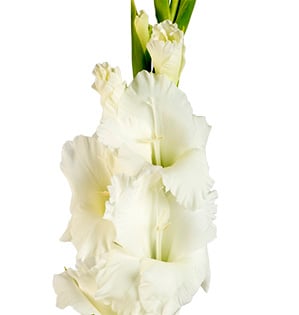Gladiolus

Common Names: Gladiolus, Sword Lily, Glad, Corn Flag
Botanical names: Gladiolus, (gla-dee-OH-lus)
Availability: Year round; primary season - April through December
Vase life: 7 to 14 days
Storage temperatures: 36 - 38 degrees Fahrenheit
Ethylene Sensitive: Yes
Description: A thick stem with multiple blossoms located on one side of the stem. Blossoms may be plain, fringed or ruffled and forms may vary from trumpet shaped to rosebud-like to tulip shaped.
Color: White, pink, red, orange, yellow, purple, green and bi-colors; a wide range of bright and pastel shades are available.
Botanical facts: Gladiolus is Latin for small sword. A reference to the sword shaped leaves or the shape of a Gladiolus stem with unopened blossoms.
Design notes: Gladiolus are excellent line flowers and are frequently used in sympathy work. The individual blossoms are used in corsages and can be glued together to make composite flowers.
Purchasing hints: Purchase long unbroken stems with bright green foliage. Blossoms on the lower quarter of the stem should be starting to open with three quarters of the remaining buds showing color.
Conditioning: Remove all foliage that will be below the water line. Cut stem ends with a sharp knife. Hydrate in a solution of warm water and commercial floral food for two hours before storage or usage.
Additional notes: Gladiolus are highly geotropic and need to be stored upright until used. The tips will curve away from the pull of gravity. Fluoridated water can cause petal edge and leaf tip burn. Monitor water supply carefully as Gladiolus are very heavy drinkers. Snapping off the top inch of the stem will help promote water uptake. The shape of the gladiolus betrays the source of the flower's name. Gladiolus comes from the Latin word for a small sword. And fiery swords is indeed what these flowers resemble most, with their bright colors and their erect buds. This powerful expressiveness is undoubtedly the main reason why gladioli have always been much used in flower arrangements in southern European countries. In those hot southern countries, more so than in those colder ones further north, flower arrangements are expected to be bold and dramatic. You may well have seen giant wreaths in Italy or Greece adorned with a fan composed of gladioli. A bouquet of tall vividly-colored gladioli can be impressive - or using the smaller, daintily-patterned Nanus forms of the flower; it can be modest and subdued. As for its colors, such a floral sculpture can easily be adapted to different styles of interior design. Besides serene white gladioli there are also soft pastel colors; of course cheerful shades of red, yellow and orange, as well as quite unusual deep purple, hot pinks and deep reds.

